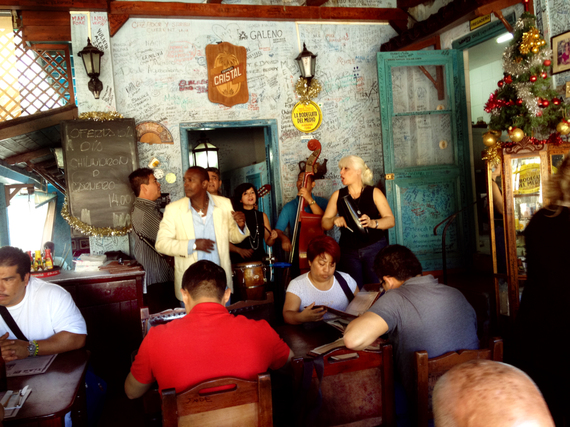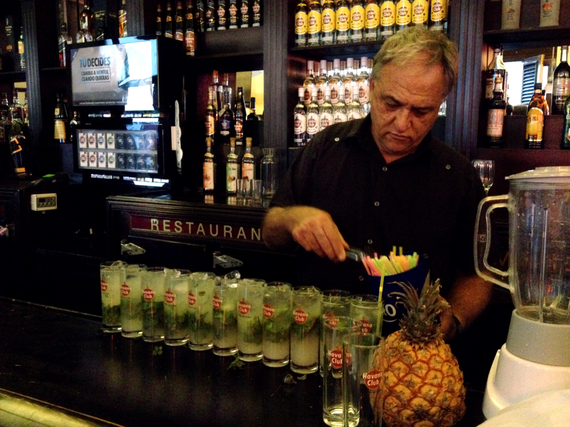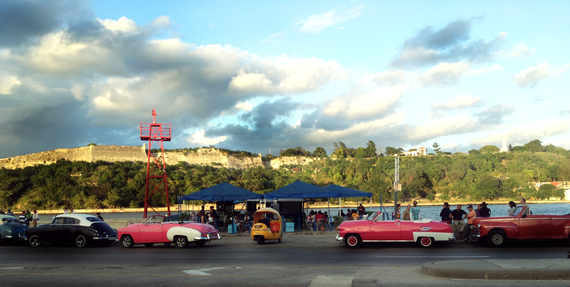This is part IV of a V-part series on my experiences in Cuba. Read Part I, Part II, Part III.& Part V
Today we are going to check into the Melia Cohiba, part of a Spanish chain of hotels I love in both Bali and Madrid.
Cousin Ofelia feeds us precious eggs for breakfast, then as we wait for our driver, Armandito, she takes me down to the street and tours me around the small mercados on her block. These are the Cuban stores the locals shop in, where their ration books are good. At the first stall, I see the scales where the ration book chicken is weighed, and note, dismayed, that there is exactly one shelf along the back where dry goods share space with a small bottle of oil. "That is why we have so little oil," Ofelia tells me in her slow English. "It is all we get each month." The vegetables at the next stall look fairly fresh; next to it is a butcher's counter and Ofelia points out the price list of the nearly unattainable free market meat. The closest I can come to comparing their plight in Western terms would be sending a homeless guy into a 5-star hotel and telling him he can stay here. He could, if he only had the $600+ a night for a room.
Once we arrive at the Cohiba (a mere $250 a night), we bring everyone inside, expecting to show them our hotel room after we check in. We have paid for the room in advance, as no Americans' credit cards are honored in Cuba. Nor do ATMs exist here; we are on a strict cash basis the whole time, and woe to any American who doesn't bring enough dollars for their full stay, including the exit visa. It's the only civilized place I know of where Americans are cut off from the world -- no internet (except in the large hotels), no banks, no cell phones (unless you arrange for a local one in advance -- the Miami non-profit, Explore International where I obtained my visa and license, can arrange this for you). No cash would mean no way to buy communication, either, possibly a welcome change for some of us in the modern world.
We check-in with no trouble, but are shocked to learn that Cubans are not allowed past the lobby. We cannot even bring the family to the room to see it. I promise to take lots of photos and they wait as we race up to the room to drop our things, shaking our heads at the unfair and embarrassing circumstance. But the truth is, they are used to it -- until recently, Cubans could only enter their little mercados, not the shops open to the visitors or even the larger supermarkets, should they be so lucky as to have the exorbitant cash needed to buy something there.
But the truth is, they are used to it -- until recently, Cubans could only enter their little mercados, not the shops open to the visitors or even the larger supermarkets, should they be so lucky as to have the exorbitant cash needed to buy something there.
Back in our spectacular 1955 Chevy, I get the same driving tour by day as I received the night before, sadly noting that Old Havana and its gracious homes look better by night; during the day, the run-down, bedraggled facades are more obvious, the city far less romantic. We drive to the center of the quarter, to Hemingway's other favorite watering hole -- La Bodeguita del Medio, literally, "the Little Store in the Middle." The downstairs bar is packed with an atlas of tourists, and we make our way up narrow staircases two stories above, the music of each floor's band accompanying us en route. Every square inch of La Bodeguita's walls is covered in the graffiti of the world's visitors. Somewhere in here, Hemingway signed "My dacquiri is La Floridita, my mojito is La Bodeguita," the latter half of which is now reproduced on the paper placemats. On the top floor, seven of us -- five Cubans and two Americans -- cram tightly at a table along the open windows, and order a round of delicious mojitos along with a variety of Cuban food: fried and roast pork, stewed chicken, black beans and rice. The total for lunch is, again, five to seven months' salary for any one of the locals. We stay for hours, listening to the raucous 5-piece band singing three-part harmony on everything from a Spanish version of "Killing Me Softly" to covers of modern Latin pop songs, Tio Arcadio gets up to dance with several of the other tourists, and I steal away for a moment to add our names to one of the graffiti walls.
 After lunch, we wander down to the spectacular church at Plaza Cathedral, strolling across the cobblestones. We stop at a tourist trap too charming to ignore: two dark-skinned Cuban women dressed all in white, their heads done up in white scarves like Mammy in Gone With the Wind, sit smoking fat stogies and laughing dirty laughs, while people pay a Chavito apiece to have their photo taken. I can't resist, and after I pose, Tio Arcadio pops down between them, puffing away on his lit cigar as their laughter echoes around the square.
After lunch, we wander down to the spectacular church at Plaza Cathedral, strolling across the cobblestones. We stop at a tourist trap too charming to ignore: two dark-skinned Cuban women dressed all in white, their heads done up in white scarves like Mammy in Gone With the Wind, sit smoking fat stogies and laughing dirty laughs, while people pay a Chavito apiece to have their photo taken. I can't resist, and after I pose, Tio Arcadio pops down between them, puffing away on his lit cigar as their laughter echoes around the square.
I stop to feed a half-dozen stray cats the single piece of American cheese I have in my bag, rejected earlier by a dog who was either not hungry or recognized that it wasn't real cheese. They mew politely and rub against my ankles as they nibble the bits of orange I throw on the cobblestones. No one bothers them or bothers about them.
 My girlfriend steers us all towards the horse-drawn carriages lining the side of the square, and I am instructed to be quiet so they can negotiate the local price. I think it will be clear from my pale skin and red hair that I'm not Cuban, but I keep my mouth shut and soon the seven of us are riding in two carriages. We pass along the waterfront just as Golden Hour is beginning, the sun turning the sky pink and warm and lighting an immense marble statue of the Christ on the distant hill. At street level, I enjoy the long, lean lines of a row of antique convertible Chevys -- pink, red, white, blue -- strutting their stuff despite being parked.
My girlfriend steers us all towards the horse-drawn carriages lining the side of the square, and I am instructed to be quiet so they can negotiate the local price. I think it will be clear from my pale skin and red hair that I'm not Cuban, but I keep my mouth shut and soon the seven of us are riding in two carriages. We pass along the waterfront just as Golden Hour is beginning, the sun turning the sky pink and warm and lighting an immense marble statue of the Christ on the distant hill. At street level, I enjoy the long, lean lines of a row of antique convertible Chevys -- pink, red, white, blue -- strutting their stuff despite being parked.
The carriage driver tells us the very best mojito is at a bar called Dos Hermanos (Two Brothers) which claims to be the oldest bar in Cuba, and we agree to stop. The drinks are only $3 US each, and my friend generously buys them for our drivers as well, and we all sit to enjoy the delicious local specialty and listen to the Cuban band. At one point, some of the staff come over, and the next thing I know, I am being twirled around the floor in front of the mahogany bar, next to a young European girl who is also game to dance. Afterwards, the drivers drop us off at one of the main squares, and we hook back up with Armandito.
 On the way to the hotel, we stop at the Buena Vista Social Club, as I am a huge fan of the CDs released over the years, and am hoping to see them that night. But as we climb to the top floor of the multi-story venue, I become disenchanted. Tickets are US $50 each, and I can see that the tables are crowded together. Tonight, I know they will be full of tourists listening to a show put on for visitors, more production than performance. When we descend to the box office, I decline the opportunity, preferring to focus on the smaller, more authentic bands I have been hearing everywhere we go.
On the way to the hotel, we stop at the Buena Vista Social Club, as I am a huge fan of the CDs released over the years, and am hoping to see them that night. But as we climb to the top floor of the multi-story venue, I become disenchanted. Tickets are US $50 each, and I can see that the tables are crowded together. Tonight, I know they will be full of tourists listening to a show put on for visitors, more production than performance. When we descend to the box office, I decline the opportunity, preferring to focus on the smaller, more authentic bands I have been hearing everywhere we go.
Back at the hotel in the early evening, meaning to go out that night, we drift into a nap that lasts until morning. It's been wonderful but exhausting, and now we are refreshed for our last day in Havana.
